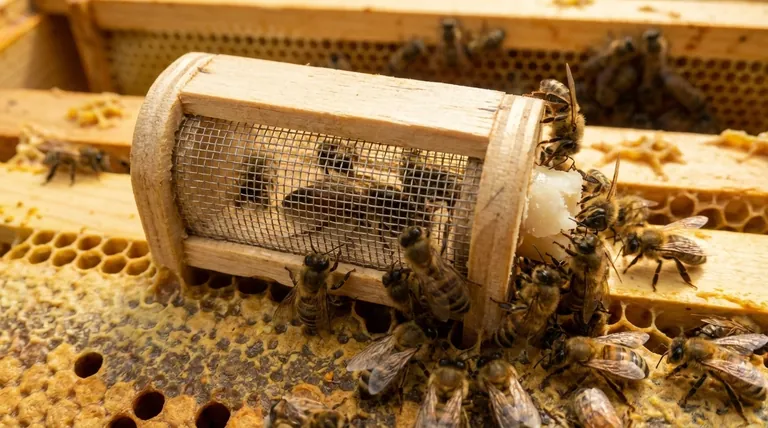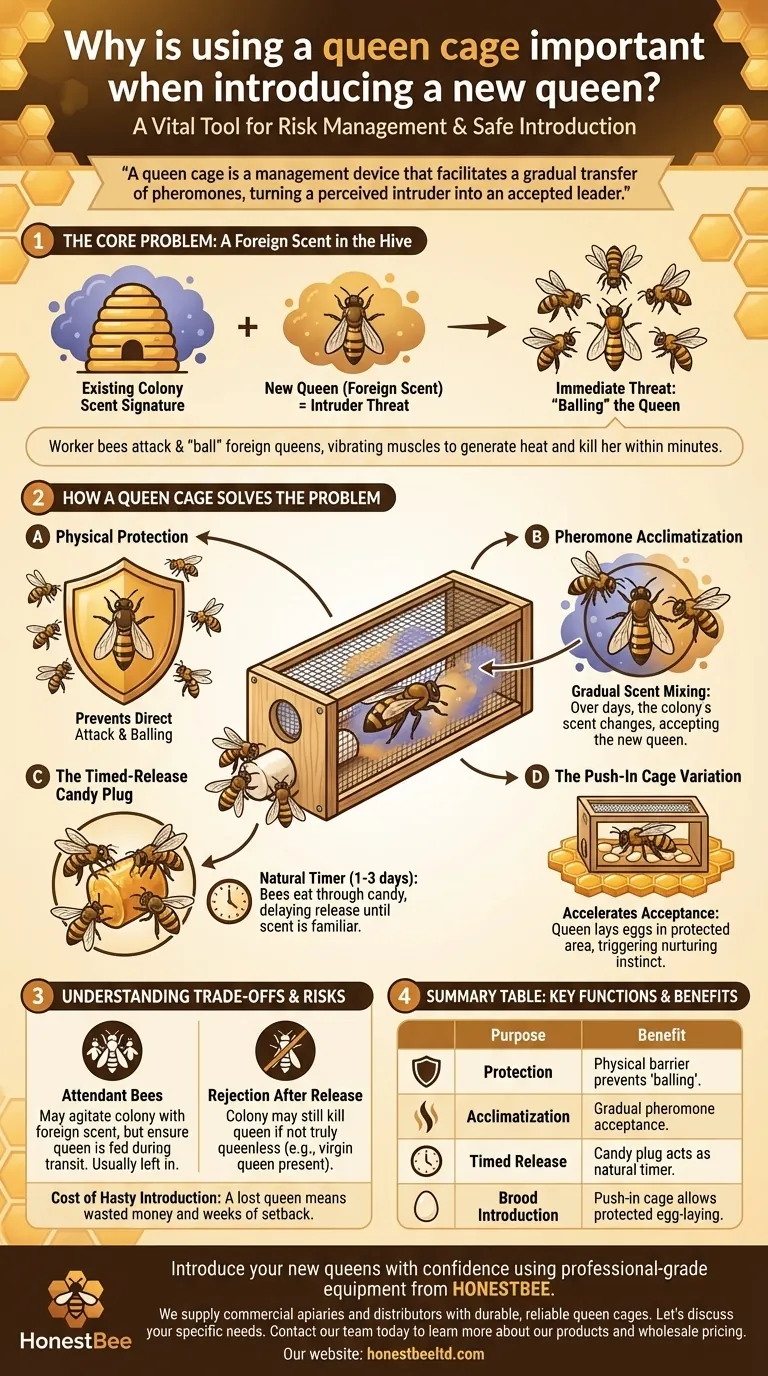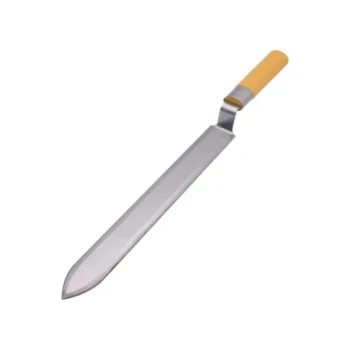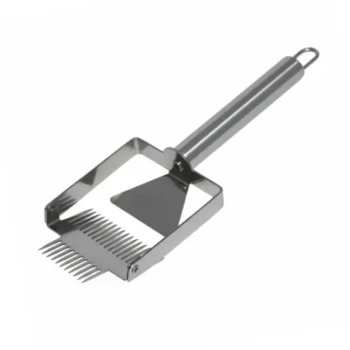At its core, a queen cage is a vital tool used to manage risk. Its primary purpose is to protect a new queen from being killed by the very colony she is meant to lead, allowing for a slow and safe introduction while her scent becomes familiar to the hive.
A queen bee's success or failure hinges on her acceptance by the colony, which is governed by scent. A queen cage is not just a container; it is a management device that facilitates a gradual transfer of pheromones, turning a perceived intruder into an accepted leader.

The Core Problem: A Foreign Scent in the Hive
Understanding Colony Pheromones
Every honeybee colony has a unique scent signature, a complex cocktail of pheromones originating primarily from the resident queen. This scent is how bees recognize hive-mates and identify intruders.
A new queen, arriving from a different breeding colony or nucleus hive, has a foreign scent. To the worker bees, this scent signals an immediate and dangerous threat to their existing social order.
The Immediate Threat: "Balling" the Queen
When worker bees perceive a foreign queen, their defensive instinct is to attack and kill her. They will swarm around her, forming a tight ball—a behavior known as "balling."
The bees in the ball vibrate their wing muscles to generate intense heat, effectively "cooking" the queen to death while also stinging her. Without protection, a newly introduced queen can be killed within minutes.
How a Queen Cage Solves the Problem
Physical Protection
The most obvious function of the cage is to act as a physical barrier. It prevents the worker bees from directly attacking, stinging, or balling the queen while she is vulnerable.
Pheromone Acclimatization
The cage is designed with mesh or holes that allow for limited contact. Worker bees can touch the queen with their antennae and even feed her through the screen.
This interaction is critical. It allows the queen's unique pheromones to slowly permeate the hive. Over a period of days, the colony's collective scent begins to change, incorporating the new queen's signature until she is no longer perceived as a threat.
The Timed-Release Candy Plug
Most modern queen cages have a small tube filled with a sugar paste or "candy." This candy plug blocks one exit of the cage.
The beekeeper installs the cage, and the worker bees immediately begin to eat the candy to free their "trapped" queen. This process typically takes one to three days, serving as a natural timer for her release. By the time the candy is gone, the colony has usually accepted her scent.
The Push-In Cage Variation
A push-in cage is a larger screen cage without a bottom. The beekeeper presses it into a section of honeycomb that contains nectar and empty cells.
This method allows the queen to begin laying eggs in a protected area. Once worker bees sense her laying, their instinct to nurture brood often overrides their defensiveness, drastically increasing the odds of a successful introduction.
Understanding the Trade-offs and Risks
The Role of Attendant Bees
Queens are often shipped with a few attendant bees inside the cage to care for her during transit. While they ensure she is fed, some beekeepers remove them before introduction.
The concern is that the attendants carry the foreign scent of their original hive, which may agitate the new colony. However, removing them risks injuring or accidentally releasing the queen prematurely. For most situations, leaving them is standard practice.
Rejection After Release
Using a cage is not an absolute guarantee. A colony may still reject a queen if it is not truly "queenless." The presence of an undiscovered virgin queen, a failed queen, or laying workers can all lead to the new queen being killed upon release.
The Cost of a Hasty Introduction
Failing to use a cage is a high-risk gamble. A lost queen means wasted money and, more importantly, a significant setback for the colony's development. A hive can remain queenless for weeks, shrinking its population and productivity.
Making the Right Choice for Your Goal
Introducing a new queen is a delicate process that requires patience. The queen cage is your most reliable tool for managing bee behavior and ensuring a smooth transition.
- If your primary focus is introducing a queen to a calm, hopelessly queenless hive: The standard cage with a candy plug is the most common and effective method.
- If your primary focus is saving a difficult or aggressive colony: A push-in cage is a superior choice, as allowing the queen to lay eggs accelerates her acceptance.
- If your primary focus is installing a new package of bees: Always use the supplied queen cage and follow the instructions for a timed release to ensure the new colony accepts her as they establish their home.
Ultimately, the queen cage empowers you to guide the colony's natural instincts toward acceptance rather than rejection.
Summary Table:
| Purpose | Key Function | Benefit |
|---|---|---|
| Protection | Physical barrier prevents 'balling' | Shields the queen from immediate attack |
| Acclimatization | Mesh allows scent and food transfer | Gradual pheromone acceptance by the colony |
| Timed Release | Candy plug acts as a natural timer | Queen is released only after scent is familiar |
| Brood Introduction | Push-in cage allows protected egg-laying | Laying instinct accelerates acceptance |
Introduce your new queens with confidence using professional-grade equipment from HONESTBEE.
We supply commercial apiaries and beekeeping equipment distributors with the durable, reliable queen cages and tools needed to manage hive transitions successfully. Our wholesale-focused operations ensure you get the quality supplies your business depends on.
Let's discuss your specific needs. Contact our team today to learn more about our products and wholesale pricing.
Visual Guide

Related Products
- Double Head Beekeeping Grafting Tools for Beekeepers
- Queen Bee Marking Tube Cage Bottle Catcher Holder with Clear Plastic Plunger Marker
- Plastic Queen Bee Catcher Marker Tube Holder for Queen Marking Bottle
- Professional 3-Bar Frame Grip with Integrated Hive Tool
- Professional Dual-End Stainless Steel Hive Tool for Beekeeping
People Also Ask
- How should the selected brood frame be prepared for grafting? A Step-by-Step Guide to Protect Larval Viability
- What tools are commonly used for grafting? Master Queen Rearing with the Right Tool
- When do queens emerge after grafting? Master the 12-Day Critical Window
- Why is controlled mating important in honey bee breeding? Master Genetic Selection for Superior Bees
- What should be done with extra queens from grafting? A Strategic Guide for Apiary Management



















